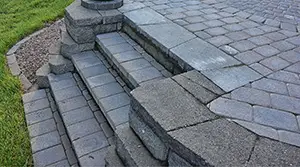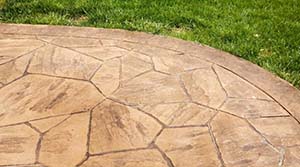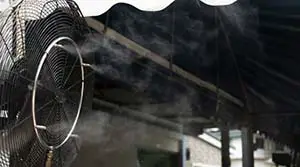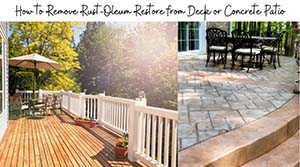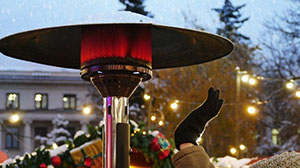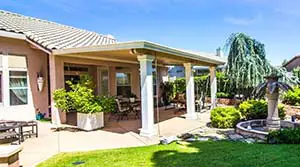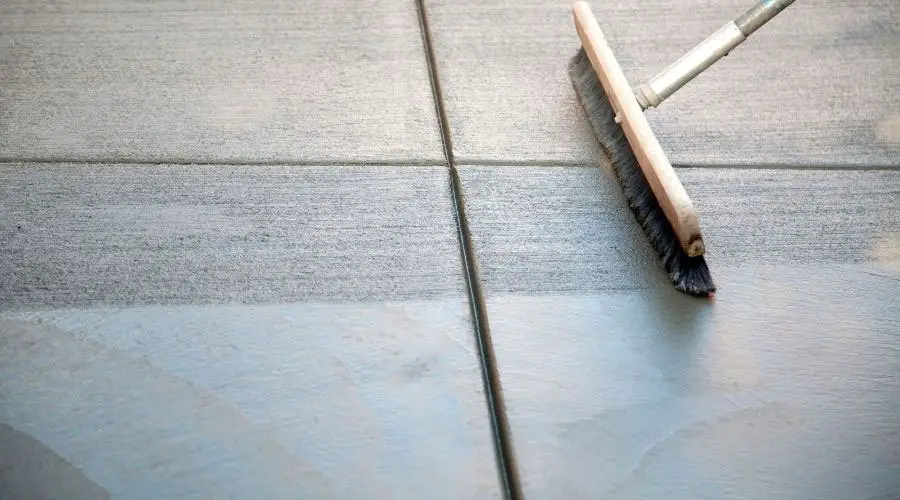
An outdoor concrete patio or walkway is a convenient and stylish addition to your home. It can even increase the value of your home and improve its curb appeal.
However, when left unclean, that concrete patio that used to be attractive can be a potential nuisance if you haven’t kept up with maintenance.
In that case, you may have to clean it, which will be roughly once a year to allow it to look reasonably decent for years to come. However, what can you use aside from pressure washing to help your patio look fresh? Here are six ways you can do so:
- Use white vinegar
- Mix water & baking soda together
- Spray with bleach & scrub with a deck brush
- Use a commercial cleaner for rust stains
- Spray chlorine bleach to remove molds
- Put cornstarch on grease and oil stains
While your concrete patio gets exposed to many weather conditions, it can generally withstand most of them.
The biggest concern is the grime and gunk that can build up on the surface over time. In addition, you may notice mold, mildew, and even rust stains starting to make your concrete patio or other surfaces look unsightly.
Nothing is more satisfying than a freshly cleaned concrete surface around your home. But you might be wondering how to clean a concrete patio, especially if you don’t have a pressure washer of your own. Let us go more in detail down below.
How Do You Make an Old Concrete Patio Look New?
Most homeowners are surprised when we tell them that their old concrete patio does not need reconstruction all over to look new.
Here are some of the simple yet effective ways to make an old concrete patio look as if you just constructed it yesterday:
- Regular sweeping. This can remove large amounts of dust, dirt, leaves, and other debris from the trees and nearby gardens that can be tracked onto it. Sweeping can be done daily or weekly to help keep your patio looking great.
- Resurfacing. For old concrete patios that have had years of neglect, the best option is to resurface the entire patio, driveway, or walkway.
While this sounds like a tough and costly job, it can be done over the weekend and might be more affordable than you think.
- Clean the surface. Ensure the concrete surface is well cleaned and free from dirt and debris. You can use a regular garden hose or a long-handled scrub brush to give the area a good washing before you get started with resurfacing, repairs or repainting.
- Repair cracks. After the surface has been thoroughly cleaned, now is the perfect time for minor repairs such as filling cracks.
There are various masonry kits you can purchase at home repair stores to make this much easier on you. You likely won’t need a large amount of repair mortar, so hiring a professional is no need to buy large bags or waste your money.
- Apply new coating. There is a wide range of colors and textures you can choose from, and there are methods you can use to add your very own custom touch with a unique design or by adding better traction.
How Do You Clean a Concrete Patio Without a Pressure Washer?
Having a pressure washer can sometimes make the cleaning process much easier and faster, but it can also cause irreversible damage to some surfaces around your home.
Depending on the strength of a pressure nozzle, the water can cause the edges of concrete patios to chip or break. It can also cause more damage to currently minor issues, forcing you to hire someone to repair them properly.
There are many ways to get a deep clean without using a pressure washer. You may have to put in a bit more work yourself, but the finished results will be just as good if not better than what a pressure washer could provide. It will also end up being much more affordable to you over time.
Some of the best and most common cleaning products you probably already have in your home may include baking soda, vinegar, borax, dish soap, bleach, and powdered laundry detergent.
Each can be used alone or combined with other products to create simple but effective cleaning products.
1. Use White Vinegar for Grime & Mildew Buildup
Vinegar is an all-natural and very easy to obtain liquid. Most homes already have this item in their kitchen or can bring some white vinegar quickly from the grocery store. It’s excellent for cleaning indoor and outdoor surfaces, including your concrete patio.
Vinegar is highly acidic but not dangerous acidity levels like some commercial cleaning products. It is a highly effective stain remover, and you can use it on concrete, brickwork, metal outdoor furniture, and many other surfaces.
When using vinegar to clean a surface, always use white vinegar. Apple cider vinegar is not a suitable cleaning agent and will not give you the same results.
White vinegar can be used without any dilution or diluted with water. For heavy stains on concrete patios, you may want to use undiluted vinegar and let it sit for 10 minutes or more before scrubbing and rinsing.
After using vinegar to wash a surface, rinse the area down with a garden hose that helps remove the vinegar and the grime and mildew.

2. Mix Water & Baking Soda for Hard-to-Reach Places on Your Concrete Patio
Another ubiquitous product most people already have in their homes is baking soda. This prevalent product makes a great cleaning paste to use on a wide range of indoor and outdoor surfaces. It’s environmentally friendly and safe to use in various locations and situations.
Baking soda is a powder, and when mixed with water, it can create a thick paste that is great for getting into hard-to-reach places around your home.
Baking soda can also be added in a small enough amount to allow it to be dissolved and sprayed with a spray bottle. In this case, mix one cup of baking soda with one gallon of water. You’ll get the same excellent cleaning effect but will be able to apply it with a sprayer.
Whether you mix it up as a liquid or a paste, allow the baking soda and water mixture to sit on the stain for around 15 minutes, giving it plenty of time to work into the nooks and crevices and break down the colors.
After it has had a chance to sit, you can use a stiff-bristled brush to give the area a good scrub, then rinse it with the garden hose. You should notice a much cleaner patio afterward.
3. Spray Your Concrete Patio With Bleach & Use a Deck Brush for Scrubbing
When it comes to more aggressive cleaning products, most people will turn to bleach. In most households, you’ll commonly find bleach as a part of their laundry cleaning products. It’s also easily found at department stores and is very affordable.
However, bleach is also very caustic and can damage plants near your patio if you get bleach on them. It does, however, do an excellent job cleaning mold and mildew stains from a concrete patio surface. It would help if you tried using other cleaning methods before reaching for the bleach, though.
When using bleach, always be sure to wear rubber gloves. Standard kitchen cleaning gloves are excellent. You don’t want to get bleach on your hands or into an open sore.
You should also wear old clothing you don’t mind if it gets stained, as bleach can quickly remove the color from clothing and, if left on the surface, can also create holes in the fabric.
The best way to use bleach is in a 1:1 ratio. Mix it up and place it in a spray bottle. You can then apply the mixture to any surface directly.
Using a spray bottle will not only help you direct the bleach where it needs to go, but it will also help prevent a high concentration of acidic liquid in a single spot.
After the bleach solution has been on the surface for around 10 minutes, you can use a deck brush to scrub the area further.
Scrubbing the area ensures the stain gets removed thoroughly. After washing, give the place a thorough rinse with water from the garden hose.
4. Use a Commercial Cleaner That Includes Oxalic Acid for Rust Stains
Rust stains are typically from the legs of a BBQ grill or metal patio furniture. Unfortunately, rust stains can be difficult to remove from concrete.
It is wise to avoid chlorine bleach entirely as this can further set the stains into the concrete, making it next to impossible to extract.
Instead, you can use a commercial cleaner that includes oxalic acid in its list of ingredients. This acid is highly effective at removing the iron in rust stains.
Always be sure you use a broom to remove the surface dirt and debris because it helps ensure the cleaning product is needed.
After you clean the surface, follow the directions on the cleaner you purchased. It may need to be diluted with water or placed on the stain directly. Scrub it with a stiff-bristled brush thoroughly before rinsing the area. You should notice many of the rust stains have been removed.
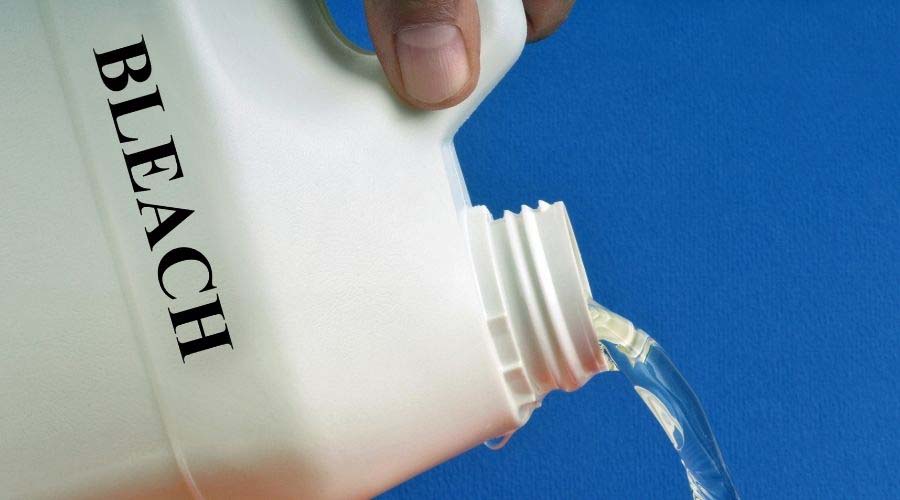
5. Spray Chlorine Bleach to Remove Molds
Mold and mildew stains on a patio are widespread in areas that receive high humidity. They can, however, be very unsightly and make your deck look aged and worn down. Removing them is easy but may take some elbow grease from you.
Chlorine bleach is the best solution here. Oxygen-based bleach will not kill the spores, so always use chlorine bleach only. Chlorine bleach also works for black mold, algae, and surface grime.
You can mix the bleach with water in a 1:2 ratio. You can then use a spray bottle to get the bleach solution on the surfaces needed most.
Keep in mind, however, that chlorine bleach is not plant-friendly. If you get it on your grass or any plants nearby, it will kill them. So be warned and take care when spraying it on the edge of your patio.
Once you have sprayed the solution on the surface, allow it to sit for 20 minutes giving the bleach time to thoroughly kill the mold and mildew spores, preventing them from coming back in the future.
Once the bleach mixture has sat on the surface for a while, give the area a good scrub before rinsing it off. Be sure to thoroughly rinse the area to remove all of the bleach and any loose mold and mildew spores that may still be present.
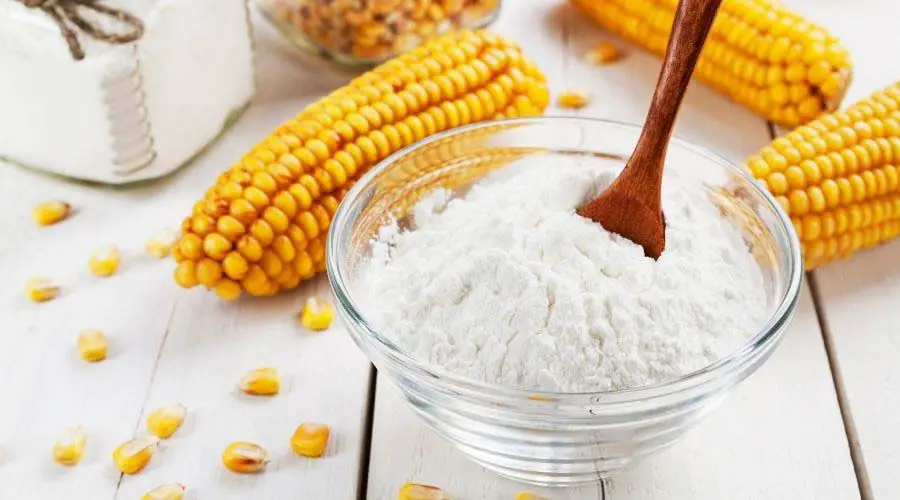
6. Put Cornstarch on Grease and Oil Stains
Grease and oil stains are tough to remove once they are set in. If you notice grease or oil stains early on, you may be able to minimize the stains they leave behind if you act quickly.
The easiest way to absorb the majority of the grease or oil is by placing a thick layer of cornstarch on the liquid. Let the cornstarch sit on the liquid for at least 24 hours. This will help absorb the excess liquid and make it easier to brush into a dustpan.
Once it has been dried as well as possible with this method, apply a cleaner to the surface. You may choose to use a commercial cleaner precisely to remove grease stains or use a water and dish soap mixture.
Dawn brand liquid dish soap is the best dish soap for removing grease and oil, but many others may work equally well.
What is the Best Concrete Patio Cleaner?
The best homemade cleaning solution for most concrete patios is baking soda and chlorine bleach. It is pretty simple and highly effective but dangerous to plants and grass.
- Mix 2 parts baking soda with 1 part chlorine bleach
- Wear rubber gloves and mix the solution in a bucket
- Grab a scrub brush with thick and stiff plastic bristles
- Scrub the bleach and baking soda solution onto the stained surface
- Rinse thoroughly with clean water from the garden hose
Conclusion
While having a pressure washer may make cleaning your patio and outdoor furniture easier on you, it can end up causing damage to your stonework, grout, and other areas.
Putting in a bit of physical effort on your part can help save money and prevent damages from the high-powered water jet of a sprayer.
No matter what method you may choose to clean your concrete patio, know that it will soon look great after you remove the mold, mildew, algae, rust, or other grime that is making it unsightly.
Sources

